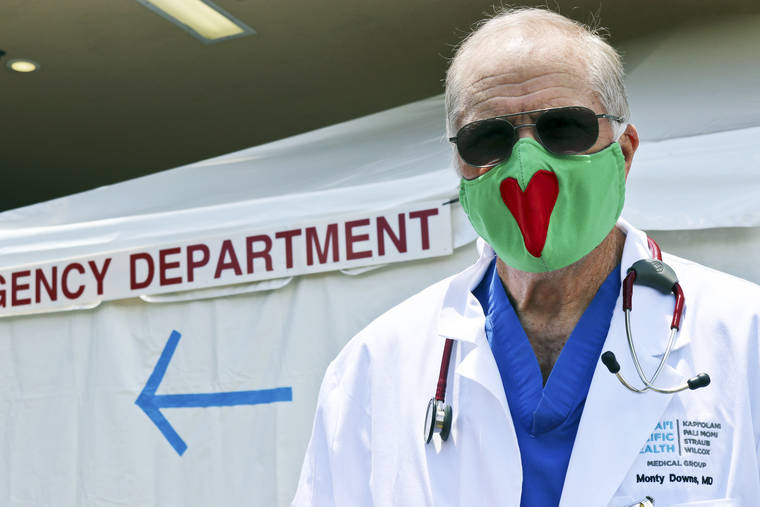2021 has arrived, and I always try to take a moment to reflect back on the year that just happened, in particular from my perspective as an ocean-safety advocate.
Similarly to the year after ‘Iniki when there were very few visitors on Kaua‘i, our drownings were way down in 2020. There are always slightly different versions of the statistics (e.g. does a body found washed up on a beach qualify as a drowning?), but four Kaua‘i drownings in 2020 seems to be the most-widely-accepted number. This is indeed way down from our brutal 18 in 2019. Also way down are our lifeguard rescues, our lifeguard preventions, our public-access rescue-tube rescues — and, of course, our overall beach numbers.
It’s of course ridiculous to come away with much happiness about this reduction in drowning deaths, since the cause of it — namely the loss of our No. 1 industry — has been catastrophic for so many families who have lost their jobs and businesses. (Not to mention the fact that four drownings is still four people, taking down with them their families and friends). Just as it’s ridiculous to take much joy from our pleasant traffic situation on our roads. We’re doing just about as well as any place in the world in terms of containing the COVID-19 pandemic, but at a severe cost.
This cost is passed not only onto individuals but also onto businesses large and small, and also onto our government. Not to mention onto our youth, many of whom have been relegated to on-line, virtual learning, and in the case of our student athletes, complete loss of their teams and competitions. I know some of our youth, and I have to use the word “damaging” when I think about what has happened to them.
With minimal in the way of GET taxes and hotel-room taxes, the state and county revenues are drastically reduced as I noted, and one has to assume that budget reductions will follow. We’ve already heard the governor float the idea of furloughs in various State departments.
So far, from my ocean-safety bias, we seem to have held out pretty well in terms of funding our lifeguards (as well as fire and police personnel). But trouble looms, since the state didn’t furlough the lifeguard positions they used to pay for in order to guard Ke‘e State Park. They simply eliminated them several months ago, without fanfare.
Here on Kaua‘i we have been very fortunate that our mayor and our council have maintained lifeguard coverage at Ke‘e through June 30. But after that, who knows what will happen? One thing I do know is that if we lose our lifeguards there we will have drownings there. As many of us know, the beautiful and calm-appearing Ke‘e lagoon harbors a rip current that will take the unsuspecting out the western portal of the lagoon and on down the NaPali Coast, often never to be seen again.
This is just one example of challenges that will lie ahead in ocean safety. The biggest overall challenge will be when we’ve successfully “opened up” and our visitor industry is again booming and our beaches are packed with people who are clueless about ocean hazards.
Then we’ll have to buckle down harder than ever with our educational and preventive efforts while retaining our lifeguarding — which, of course, is the rock foundation for any ocean-safety program.
Many of us on the Kaua‘i Lifeguard Association board of directors agree that a key to effective educational and preventive efforts lies in social media. I myself am a Facebook and Instagram nobody, and realizing this, I stepped down after a 10-year run as president. Our new president, waterwonderwoman Laola A’ea, and our new vice president, retired Duke’s General Manager Jaime Arreola, are very aware of this challenge, and are locking onto it. I remain on as secretary, and we have 14 directors and members. And, most importantly of all, we have our sponsors and donors who believe in us and our mission.
That said, in-person education and prevention also will be huge, as they always have been. This again starts with our lifeguards themselves, and continues on to our visitor industry employees such as concierges, service staff, waiters, rental-car agents, grocery-store cashiers, etc., etc. Last and not least, you and me, whenever we have an opportunity to say “please be careful.”
First things first, however. Ocean safety will necessarily be on the back burner until COVID-19 gets straightened out and until jobs and the economy are back and up and running. Back burner, however, does not mean taken off the stovetop, and those of us who have tried to minimize our tragic drownings will certainly continue to do so.
One final comment: With thanks to some very dedicated volunteers, namely Bill and Lisa Prinzing, Cory Todd, Jenna Crissler, Jill and Casey Wenderlich, Mike Tabonair, Dennis Bosio, Rick Gerding, Carol Pratt and Branch Lotspeich, our public-access rescue-tube stations are being well maintained (except that Eastside shoreline erosion at beaches such as Wailua has washed some stations out to sea). As with all our 2020 “numbers” across the board, rescues that we can trace to the presence of these rescue-tube stations is way down from prior years, but you never know when one will “come in handy.” And when one comes in handy it is a big deal — it’s a life saved.
•••
Monty Downs, M.D., is secretary of the Kaua‘i Lifeguard Association.


